Holopyga
| Notice: | This page is derived from the original publication listed below, whose author(s) should always be credited. Further contributors may edit and improve the content of this page and, consequently, need to be credited as well (see page history). Any assessment of factual correctness requires a careful review of the original article as well as of subsequent contributions.
If you are uncertain whether your planned contribution is correct or not, we suggest that you use the associated discussion page instead of editing the page directly. This page should be cited as follows (rationale):
Citation formats to copy and paste
BibTeX: @article{Paukkunen2015ZooKeys, RIS/ Endnote: TY - JOUR Wikipedia/ Citizendium: <ref name="Paukkunen2015ZooKeys">{{Citation See also the citation download page at the journal. |
Ordo: Hymenoptera
Familia: Chrysididae
Name
Holopyga Dahlbom, 1845 – Wikispecies link – Pensoft Profile
- Holopyga Dahlbom, 1845: 4.
Note
This genus consists mainly of broad-bodied wasps, with a body length of 4–9 mm. Morphological characters of the genus include the strongly curved medial vein of the forewing (Fig. 7), the setose medial cell of the forewing, the multidentate tarsal claw (Fig. 3), the carinate and angulate mesopleuron and the evenly rounded posterior margin of T3 (without any distinct notches or prominences). Some species are sexually dimorphic with contrasting colouration in the different sexes (e.g. Holopyga fervida). The biology of most species is poorly known. Apparently, the hosts consist of ground-nesting crabronid and sphecid wasps. Records stating megachilid solitary bees as hosts are questionable due to the lack of supporting data. Holopyga is a large genus with more than 90 recognised species worldwide. The vast majority of these, nearly 70 species, occur in the Palearctic Region (Kimsey and Bohart 1991[1], Arens 2004[2]). A total of 43 species are known from Europe, and four have been found in the Nordic and Baltic countries (Rosa and Soon 2012[3], Paukkunen et al. 2014[4]). We have divided the genus into species-groups according to Linsenmaier (1959)[5].
Key to Holopyga species of the Nordic and Baltic countries
Taxon Treatment
- Paukkunen, J; Berg, A; Soon, V; Ødegaard, F; Rosa, P; 2015: An illustrated key to the cuckoo wasps (Hymenoptera, Chrysididae) of the Nordic and Baltic countries, with description of a new species ZooKeys, (548): 1-116. doi
Images
|
Other References
- ↑ Kimsey L, Bohart R (1991) [1990] The Chrysidid Wasps of the World. Oxford Press, New York, 652 pp.
- ↑ Arens W (2004) Revision der Gattung Holopyga auf der Peloponnes mit Beschreibung zweier neuer Arten (Hymenoptera: Chrysididae). Linzer biologische Beiträge 36: 19–55.
- ↑ Rosa P, Soon V (2012) Fauna Europaea: Chrysididae. In: Mitroiu M (Ed.) Fauna Europaea: Hymenoptera, version 2.5. http://www.faunaeur.org [accessed 1 April 2015]
- ↑ Paukkunen J, Rosa P, Soon V, Johansson N, Ødegaard F (2014) Faunistic review of the cuckoo wasps of Fennoscandia, Denmark and the Baltic countries (Hymenoptera: Chrysididae). Zootaxa 3864: 1–67. doi: 10.11646/zootaxa.3864.1.1
- ↑ Linsenmaier W (1959) Revision der Familie Chrysididae (Hymenoptera) mit besonderer Brücksichtigung der europäischen Spezies. Mitteilungen der Schweizerischen Entomologischen Gesellschaft 32: 1–232.


